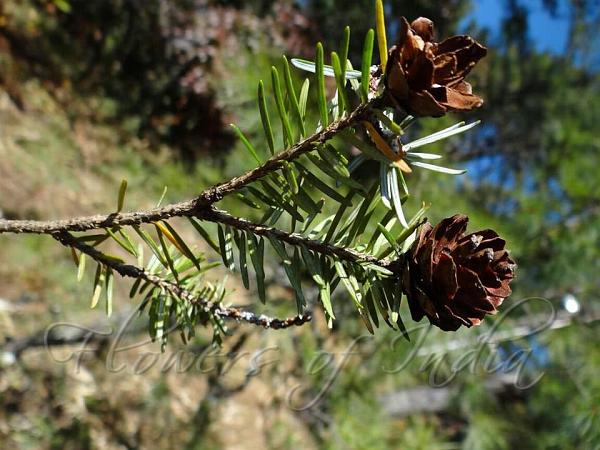|
| Himalayan Hemlock |
|

|

|
|
|
|
Photo: |
Botanical name: Tsuga dumosa Family: Pinaceae (Pine family)
Synonyms: Pinus dumosa, Abies dumosa, Tsuga leptophylla
Synonyms: Pinus dumosa, Abies dumosa, Tsuga leptophylla
Himalayan Hemlock is a coniferous tree growing
20-25 m tall. The diameter at breast height is typically 40-50 cm, but
can be beyond 100 cm. The crown on small trees is ovoid and their form
is like that of pendulous bushes - in fact, the species name
dumosa means bushy. Older trees tend to have multiple stems from
one or two sinuous boles, especially in cultivation. The crown of
mature trees is broad, irregular-pyramidal and open. The bark is
somewhat pinkish to grey-brown and heavily ridged with broad, shallow,
flaky fissures. Branches are oblique or horizontal. The twigs are
reddish brown or greyish yellow in their first year and are softly
hairy, 2-3 years old are greyish brown or dark grey with leaf scars.
The leaves are spirally arranged, pointing forward on the branches.
They are linear in shape, and 1.0-2.5 cm long by 2-2.5 mm wide. The
ends are obtuse or rounded, and very occasionally emarginate. The upper
surface is green and shiny, while the undersides have 2 wide silvery
stomatal bands. The upper half of the leaves usually have small dents
on the margins, i.e. the margins are rarely entire. Male flowers are
globose in shape, solitarily arranged and axillary. The anthers are a
green-yellow in colour and they lack an air sac. Female flowers are
round-ovate in shape, also solitarily arranged, terminal and slightly
down-curved. They have many spiral scales with 2 ovules contained
within each scale. The seeds are about 9 mm long, ovate in shape, brown
in colour and have thin wings in their upper parts. Himalayan Hemlock
is native to the eastern Himalayas, from Kumaun to Bhutan, N. Burma, at
elevations of 2100-3600 m. Flowering: April-May.
| Identification credit: Soni Bisht | Photographed in Dharchula, Uttarakhand. |
• Is this flower misidentified? If yes,